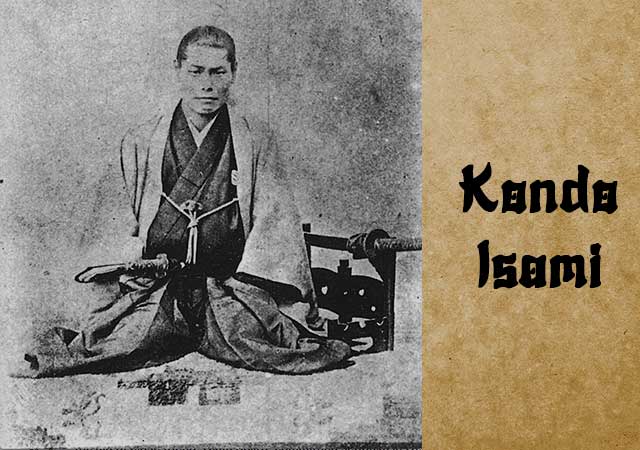
Kondo Isami, a highly skilled swordsman and the Commander of the Shinsengumi, was born in Kami-Ishihara, a quaint farming village in Chofu, western Tokyo, under the name Miyagawa Katsugoro. His journey into the samurai caste began when Kondo Shusuke adopted him. The catalyst for this adoption was Kondo's valiant defense of his family home at the age of 13 against a band of robbers.
Demonstrating exceptional swordsmanship, Kondo became the fourth master of the Tennen Rishin-Ryu in 1861. Subsequently, in 1863, the Tokugawa Shogunate enlisted 234 ronin as bodyguards for Shogun Iemochi. Kondo and his associates, initially part of the Roshigumi, served as police under the Tokugawa in Kyoto. This group eventually evolved into the notorious Shinsengumi, credited with uncovering and suppressing a potential rebellion in the Ikedaya Incident.
While celebrated as courageous heroes, Kondo and the Shinsengumi gained notoriety for their ruthless tactics, often eliminating perceived opponents to advance their agenda. Internal strife and assassinations within the group further tarnished their reputation. Notably, Kondo Isami was implicated in the assassination of statesman Sakamoto Ryoma.
The downfall of the Tokugawa Shogunate led to the Boshin War during which the Shinsengumi, including Kondo, participated in the Battle of Toba-Fushimi. Kondo sustained injuries from gunfire in this conflict and also fought in the Battle of Koshu-Katsunuma before surrendering to Imperial forces.
Following his capture, Kondo spent 20 days in jail in Itabashi, Tokyo, before facing execution at the Itabashi grounds on May 17, 1868. His grave and memorial stone stand as testaments to his legacy. Kondo Isami, at the age of 33, was laid to rest at Ryugen-ji Temple in Tokyo's Mitaka, while his severed head, initially displayed publicly, was later stolen and discreetly interred in a small mound behind Hozo-ji, an ancient temple in Okazaki, Aichi Prefecture.
See also
-
Yamagata Masakage

Masakage was one of Takeda Shingen’s most loyal and capable commanders. He was included in the famous list of the “Twenty-Four Generals of Takeda Shingen” and also belonged to the inner circle of four especially trusted warlords known as the Shitennō.
-
Yagyu Munenori

Yagyū Munenori began his service under Tokugawa Ieyasu while his father, Yagyū Muneyoshi, was still at his side. In 1600, Munenori took part in the decisive Battle of Sekigahara. As early as 1601, he was appointed a kenjutsu instructor to Tokugawa Hidetada, Ieyasu’s son, who later became the second shogun of the Tokugawa clan.
-
Yagyu Muneyoshi

A samurai from Yamato Province, he was born into a family that had been defeated in its struggle against the Tsutsui clan. Muneyoshi first took part in battle at the age of sixteen. Due to circumstances beyond his control, he was forced to enter the service of the Tsutsui house and later served Miyoshi Tōkei. He subsequently came under the command of Matsunaga Hisahide and in time became a vassal first of Oda and later of Toyotomi.
-
Endo Naozune

Naozune served under Azai Nagamasa and was one of the clan’s leading vassals, renowned for his bravery and determination. He accompanied Nagamasa during his first meeting with Oda Nobunaga and at that time asked for permission to kill Nobunaga, fearing him as an extremely dangerous man; however, Nagamasa did not grant this request.
-
Hosokawa Sumimoto

Sumimoto came from the Hosokawa clan: he was the biological son of Hosokawa Yoshiharu and at the same time the adopted son of Hosokawa Masamoto, the heir of Hosokawa Katsumoto, one of the principal instigators of the Ōnin War. Masamoto was homosexual, never married, and had no children of his own. At first he adopted Sumiyuki, a scion of the aristocratic Kujō family, but this choice provoked dissatisfaction and sharp criticism from the senior vassals of the Hosokawa house. As a result, Masamoto changed his decision and proclaimed Sumimoto as his heir, a representative of a collateral branch of the Hosokawa clan that had long been based in Awa Province on the island of Shikoku. Almost immediately after this, the boy became entangled in a complex and bitter web of political intrigue.
-
Honda Masanobu

Masanobu initially belonged to the retinue of Tokugawa Ieyasu, but later entered the service of Sakai Shōgen, a daimyo and priest from Ueno. This shift automatically made him an enemy of Ieyasu, who was engaged in conflict with the Ikkō-ikki movement in Mikawa Province. After the Ikkō-ikki were defeated in 1564, Masanobu was forced to flee, but in time he returned and once again entered Ieyasu’s service. He did not gain fame as a military commander due to a wound sustained in his youth; nevertheless, over the following fifty years he consistently remained loyal to Ieyasu.
-
Honda Masazumi

Masazumi was the eldest son of Honda Masanobu. From a young age, he served Tokugawa Ieyasu alongside his father, taking part in the affairs of the Tokugawa house and gradually gaining experience in both military and administrative matters. At the decisive Battle of Sekigahara in 1600, Masazumi was part of the core Tokugawa forces, a clear sign of the high level of trust Ieyasu placed in him. After the campaign ended, he was given a highly sensitive assignment—serving in the guard of the defeated Ishida Mitsunari, one of Tokugawa’s principal enemies—an obligation that required exceptional reliability and caution.
-
Hojo Shigetoki

Hōjō Shigetoki, the third son of Hōjō Yoshitoki, was still very young—only five years old—when his grandfather Tokimasa became the first member of the Hōjō clan to assume the position of shogunal regent.

